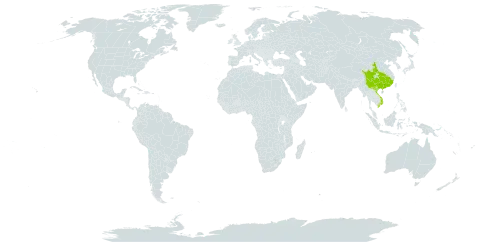Shrubs scandent, semievergreen. Branchlets brownish or dark brown to blackish brown, soft hairy when young, glabrescent, with sparse, curved prickles. Leaves simple; petiole 4–7 cm, glabrous or hairy, with sparse, slightly curved prickles; stipules caducous, free, lanceolate, to 1.8 cm, sericeous-villous or arachnoid hairy, undivided or apically lobed; blade suborbicular to broadly ovate, 5–10.5 cm in diam., palmately 5-veined, lateral veins 5 or 6 pairs, raised abaxially, impressed adaxially, thickly papery, abaxially densely gray or yellowish white tomentose or arachnoid hairy, sparsely pilose along veins, adaxially glabrous, base cordate, margin inconspicuously undulate, with uneven sharp teeth, apex shortly acuminate. Inflorescences terminal, cymose panicles, 17–27 cm; rachis and pedicels sericeous-villous or arachnoid hairy; bracts caducous, lanceolate, shorter than stipules, both surfaces sericeous-villous or arachnoid hairy, margin entire or 3-lobed apically. Pedicel 3–7 mm. Flowers 1–1.5 cm in diam. Calyx abaxially densely gray or yellowish white sericeous-villous; tube shallowly cupular; sepals ovate or ovate-lanceolate, 5–7 × 3–4 mm, margin tomentose, entire, apex acuminate. Petals absent. Stamens many, shorter than sepals; filaments subulate. Pistils ca. 15, longer than stamens, glabrous. Aggregate fruit purplish black or black, globose, ca. 1 cm in diam., glabrous; pyrenes rugose. Fl. May–Jun, fr. Jul–Aug.
More
A straggling herb. The branches are hairy. There are short curved prickles. The leaves are almost round or heart-shaped. They are 6-12 cm long by 6-8 cm wide. There are unequal teeth. The leaves can have shallow lobes. There is a white covering under the leaves. The leaf stalks are 2-4 cm long. The flowers do not have petals. They are in groups at the ends of branches. These are 15-20 cm long. The sepals are purple inside. The fruit are round and black. They are 1 cm across.
It is a subtropical plant. It is native to central and southern China. It grows on the edges of forests between 300-2,000 m above sea level. In Vietnam it has been recorded at 1,500 m above sea level. In Sichuan and Yunnan.
More
Thickets on slopes, forest margins; at elevations from 300-2,000 metres.
Can be grown by cuttings or seedlings. Seeds needs stratification.
